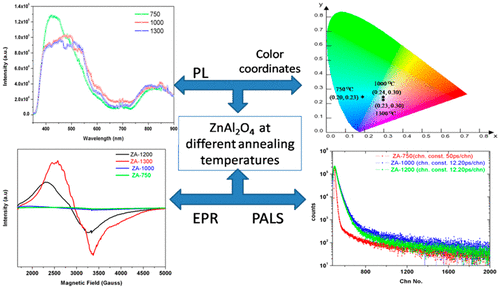当前位置:
X-MOL 学术
›
Inorg. Chem.
›
论文详情
Our official English website, www.x-mol.net, welcomes your
feedback! (Note: you will need to create a separate account there.)
Exploring Defect-Induced Emission in ZnAl2O4: An Exceptional Color-Tunable Phosphor Material with Diverse Lifetimes
Inorganic Chemistry ( IF 4.3 ) Pub Date : 2018-03-16 00:00:00 , DOI: 10.1021/acs.inorgchem.8b00172 Nimai Pathak 1, 2 , Partha Sarathi Ghosh 3 , Suryansh Saxena 4 , Dhanadeep Dutta 1 , Ashok Kumar Yadav 5 , Dibyendu Bhattacharyya 5 , Shambhu Nath Jha 5 , Ramakant Mahadeo Kadam 1, 2
Inorganic Chemistry ( IF 4.3 ) Pub Date : 2018-03-16 00:00:00 , DOI: 10.1021/acs.inorgchem.8b00172 Nimai Pathak 1, 2 , Partha Sarathi Ghosh 3 , Suryansh Saxena 4 , Dhanadeep Dutta 1 , Ashok Kumar Yadav 5 , Dibyendu Bhattacharyya 5 , Shambhu Nath Jha 5 , Ramakant Mahadeo Kadam 1, 2
Affiliation

|
Activator-free zinc aluminate (ZA) nanophosphor was synthesized through a sol–gel combustion route, which can be used both as a blue-emitting phosphor material and a white-emitting phosphor material, depending on the annealing temperature during synthesis. The material also has the potential to be used in optical thermometry. These fascinating color-tunable emission characteristics can be linked with the various defect centers present inside the matrix and their changes upon thermal annealing. Various defect centers, such as anionic vacancy, cationic vacancy, antisite defect, etc., create different electronic states inside the band gap, which are responsible for the multicolor emission. The color components are isolated from the complex emission spectra using time-resolved emission spectroscopy (TRES) study. Interestingly, the lifetime values of the various defect centers were found to change significantly from milliseconds to microseconds upon thermal annealing, which makes the phosphors more diverse (i.e., either long-persistent blue-emitting phosphors or short-persistent white-emitting phosphors). Fourier transform infrared (FTIR) and diffuse reflectance spectroscopy (DRS) confirmed the presence of antisite defect centers such as AlZn+ or ZnAl– in the matrix. X-ray absorption fine structure (EXAFS) study showed that the spinel structure was more disordered in nature for low-temperature-annealed compounds. Electron paramagnetic resonance (EPR) and positron annihilation lifetime spectroscopy (PALS) studies were also carried out in order to characterize various anionic and cationic vacancies and their clusters present in the compounds. Antisite defect centers such as AlZn+ or ZnAl–, which act as an electron or hole trap, were found to be responsible for the diverse lifetime behavior. To gain insight about the electronic states inside the band gap, density functional theory (DFT)-based calculations were performed for both pure and various vacancy-introduced spinel structures. Finally, based on the theoretical and experimental results, for the first time, a detailed investigation of various defect-induced emission behavior in ZA is presented, which also explains the mechanism of color tunability and dynamic lifetimes.
中文翻译:

探索ZnAl 2 O 4中的缺陷诱导发射:一种具有多种使用寿命的出色的颜色可调荧光材料
无活化剂铝酸锌(ZA)纳米磷光体是通过溶胶-凝胶燃烧路线合成的,视合成过程中的退火温度而定,它既可以用作发蓝光的磷光体材料,也可以用作发白光的磷光体材料。该材料还具有用于光学测温的潜力。这些引人入胜的颜色可调发射特性可以与矩阵内部存在的各种缺陷中心及其在热退火时的变化联系在一起。各种缺陷中心,例如阴离子空位,阳离子空位,反位缺陷等,在带隙内产生不同的电子态,这是造成多色发射的原因。使用时间分辨发射光谱(TRES)研究从复杂的发射光谱中分离出颜色成分。有趣的是,在热退火后,发现各种缺陷中心的寿命值从毫秒显着变化到微秒,这使磷光体变得更加多样化(即,长持久的发蓝光的磷光体或短持久的发白光的磷光体)。傅里叶变换红外(FTIR)和漫反射光谱(DRS)确认存在反位缺陷中心,如铝的Zn +或Zn的Al -在基质中。X射线吸收精细结构(EXAFS)研究表明,低温退火化合物的尖晶石结构在本质上更加无序。为了表征化合物中存在的各种阴离子和阳离子空位及其簇,还进行了电子顺磁共振(EPR)和正电子an没寿命光谱(PALS)研究。反部位缺陷中心,例如Al Zn +或Zn Al –被发现充当电子或空穴陷阱的原因是其不同的寿命行为。为了深入了解带隙内的电子状态,对纯净的和引入空位的尖晶石结构均进行了基于密度泛函理论(DFT)的计算。最后,基于理论和实验结果,首次对ZA中各种由缺陷引起的发射行为进行了详细的研究,这也解释了颜色可调性和动态寿命的机理。
更新日期:2018-03-16
中文翻译:

探索ZnAl 2 O 4中的缺陷诱导发射:一种具有多种使用寿命的出色的颜色可调荧光材料
无活化剂铝酸锌(ZA)纳米磷光体是通过溶胶-凝胶燃烧路线合成的,视合成过程中的退火温度而定,它既可以用作发蓝光的磷光体材料,也可以用作发白光的磷光体材料。该材料还具有用于光学测温的潜力。这些引人入胜的颜色可调发射特性可以与矩阵内部存在的各种缺陷中心及其在热退火时的变化联系在一起。各种缺陷中心,例如阴离子空位,阳离子空位,反位缺陷等,在带隙内产生不同的电子态,这是造成多色发射的原因。使用时间分辨发射光谱(TRES)研究从复杂的发射光谱中分离出颜色成分。有趣的是,在热退火后,发现各种缺陷中心的寿命值从毫秒显着变化到微秒,这使磷光体变得更加多样化(即,长持久的发蓝光的磷光体或短持久的发白光的磷光体)。傅里叶变换红外(FTIR)和漫反射光谱(DRS)确认存在反位缺陷中心,如铝的Zn +或Zn的Al -在基质中。X射线吸收精细结构(EXAFS)研究表明,低温退火化合物的尖晶石结构在本质上更加无序。为了表征化合物中存在的各种阴离子和阳离子空位及其簇,还进行了电子顺磁共振(EPR)和正电子an没寿命光谱(PALS)研究。反部位缺陷中心,例如Al Zn +或Zn Al –被发现充当电子或空穴陷阱的原因是其不同的寿命行为。为了深入了解带隙内的电子状态,对纯净的和引入空位的尖晶石结构均进行了基于密度泛函理论(DFT)的计算。最后,基于理论和实验结果,首次对ZA中各种由缺陷引起的发射行为进行了详细的研究,这也解释了颜色可调性和动态寿命的机理。











































 京公网安备 11010802027423号
京公网安备 11010802027423号